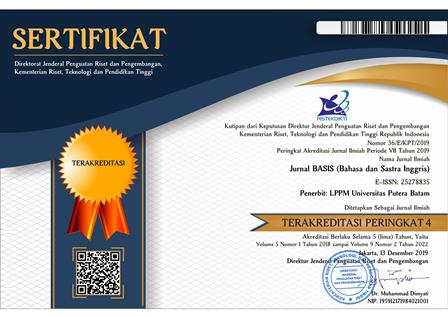CODE SWITCHING ANALYSIS IN ENGLISH LITERATURE WHATSAPP GROUP
DOI:
https://doi.org/10.33884/basisupb.v7i1.1837Keywords:
Code Switching, Inter-sentence, Intra-Sentential, TagAbstract
The aim of this research was to find out the type and reason of code switching on WhatsApp group of Putera Batam University. In collecting the data, the research applied observational method non-participatory technique. The data was analyzed by using the theory of Poplack (1980). The researchers applied the text in WhatsApp as the data. It was found 15 texts contain code switching. The data ware classified into three: tag switching, inter-sentential switching and intra-sentential switching. From the 15 text, intra-sentential switching were the most frequent type of code switching because WhatsApp group members often change language from Indonesian to English in only a few sentences that appear at the beginning, in the middle, and at the end of sentence. Code switching have ten reason using theory of Grosjean (1981). First, to fill the linguistic needs for lexical items, specify phrases, discourse markers, or sentence fillers. Second, to continue the last language used (trigger). Third, quote someone. Fourth, to determine the recipient. Fifth, to qualify the message: strengthen or emphasize. Sixth, to determine the involvement of the speaker (personal message). Seventh, to mark and emphasize group identity. Eighth, conveys confidentiality, anger, and harassment. Ninth, to exclude someone from conversation. Tenth, change the role of the speaker: Increase status, add authority, and show expertise. For reasons in the WhatsApp group only 3 of 10 kinds of reasons were found: to fill the linguistic needs for lexical items, to continue the last language used (triggered) and to determine speaker involvement.
References
Gross, M. C. . (2019). Processing of code-switched sentences by bilingual children: Cognitive and Linguistic predictors. Cognitive Development, 52(3), 142-155. https://doi.org/10.1016/j.cogdev.2019.100821
Holmes. (2001). An Introduction to Sociolinguistics. Edinburgh: Person Education Limited
Jendra, M. I. I. (2010). Sociolinguistics: The study of societies languages. Yogyakarta: Graha Ilmu.
Kamariah & Ambalegin. (2019). Analysis of using code switching in Instagram. Jurnal Basis, 6(2), 259-266. https://doi.org/10.33884/basisupb.v6i2.1431
Long, Y. (2014). Acoustic data augmentation for Mandarin-English code-switching speech recognition. Applied Acoustics, 161(3), 575-580. https://doi.org/10.4304/tpls.4.3.575-580
Poplack. (1980). Sometimes I'll start a sentence in Spanish Termino En Espanol: toward a typology of code-switching. Linguistics, 18(8), 581-618.
Sudaryanto (2015). Metode dan aneka teknik analisis bahasa. Yogyakarta, Indonesia: Sanata Dharma University Press.
Supiastutik & Rudianto. (2014). Pengaruh “Code Mixing” dan “Code Switching” terhadap kemampuan pemahaman Bahasa Inggris. Jurnal Basis, 1(2), 87-97.
http://ejournal.upbatam.ac.id/index.php/basis/article/view/300
Trousdale, G. (2010). Introduction to English Sociolinguistics. Endingburgh: University press.
WhatsApp group of English Department of Putera Batam University.
Downloads
Published
Issue
Section
License

















